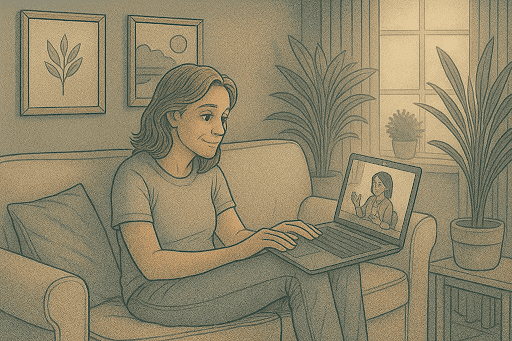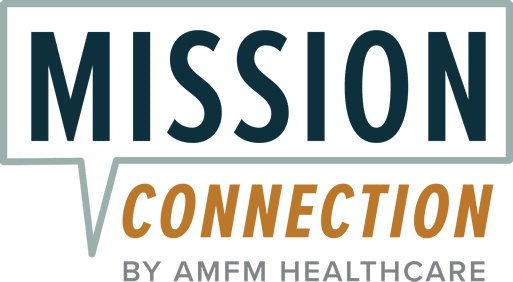
Key Takeaways
- Virtual therapy breaks traditional barriers by removing the need for travel, reducing scheduling stress, and offering a sense of comfort and privacy that helps people open up more easily.
- Modern online therapy isn’t limited to video calls as it includes secure platforms, text-based support, group sessions, and flexible scheduling options that make consistent care more accessible and convenient.
- Online therapy offers practical advantages like affordability, flexible timing, access to specialists beyond your local area, and the ability to connect from familiar, calming surroundings.
- While virtual therapy works well for most people, in-person sessions may be more suitable for those in crisis, with severe symptoms, or who need hands-on therapeutic techniques.
- Mission Connection delivers flexible, high-quality mental health care with virtual, in-person, and hybrid options, offering therapy, psychiatry, and life-skills support designed to help you thrive.
Why More People Are Turning to Virtual Therapy
The way people access mental health care is changing. Virtual therapy makes getting help easier by removing barriers like scheduling conflicts, travel, and the anxiety of visiting a therapist in person.
It also supports consistency, as online sessions are easier to attend regularly, helping clients build momentum toward lasting positive change. Many find that connecting from the comfort of home allows for a greater sense of privacy and control, making it easier to open up and engage fully in the process.
Mission Connection offers flexible outpatient care for adults needing more than weekly therapy. Our in-person and telehealth programs include individual, group, and experiential therapy, along with psychiatric care and medication management.
We treat anxiety, depression, trauma, and bipolar disorder using evidence-based approaches like CBT, DBT, mindfulness, and trauma-focused therapies. Designed to fit into daily life, our services provide consistent support without requiring residential care.
What Virtual Therapy Actually Looks Like Today
Modern virtual therapy encompasses more than just video calls. It includes high-definition video sessions, text-based therapy for ongoing support, and HIPAA-compliant platforms designed for telehealth. These platforms offer features like waiting rooms, session reminders, secure messaging, and integrated payment systems, providing a comprehensive virtual care experience.
Video Sessions vs. Text-Based Therapy

Video therapy closely resembles traditional face-to-face sessions, allowing for real-time conversation and nonverbal communication. A 2021 meta-analysis found that video-based therapy is as effective as in-person therapy for various conditions.
Text-based therapy gives accessibility through asynchronous communication. A study found that text-based therapy effectively reduces symptoms of anxiety and depression.
Group vs. Individual Online Sessions
Virtual therapy isn’t limited to one-on-one care. Online group therapy has become increasingly sophisticated, creating supportive communities around specific concerns like anxiety, depression, grief, or relationship issues. These virtual groups often cost less than individual therapy while providing valuable peer support.
Individual online therapy offers personalized attention and treatment plans specific to your specific needs. The privacy of one-on-one sessions allows for deeper exploration of personal challenges in a confidential setting. Many people alternate between individual sessions and group support depending on their needs and budget.
Therapy Apps vs. Traditional Providers Online
The mental health technology includes both dedicated therapy apps and traditional providers who’ve adopted virtual services. Therapy apps typically offer subscription-based services with features like messaging, video calls, worksheets, and mood tracking all in one platform. These integrated services appeal to tech-savvy users seeking convenience and additional tools between sessions.
Traditional providers offering virtual sessions typically maintain their usual practice structure but conduct appointments via secure video platforms. This approach often provides continuity for existing clients and maintains the familiar therapeutic relationship while adding convenience. Many established therapists now offer hybrid models, seeing some clients in person and others virtually based on preference and need.
7 Major Benefits of Virtual Mental Health Support
Virtual therapy enhances accessibility, affordability, and overall engagement in mental health care. For many, online options remove barriers that once made consistent therapy difficult or impossible. Here are seven key advantages driving its popularity:
1. Accessibility for Those with Limited Mobility
Virtual therapy removes physical barriers, allowing people with disabilities, chronic illnesses, or mobility restrictions to access care from home. Parents, immunocompromised individuals, and those recovering from illness can maintain consistency without complicated logistics, ensuring support is uninterrupted even during challenging times.
2. No Travel Time or Transportation Costs
Online sessions eliminate commuting, save time, and reduce expenses like gas, parking, public transit, and childcare. This convenience makes therapy more sustainable, and the extra time can be redirected to self-care, work, or family.
3. More Affordable Options and Payment Plans
Without office overhead, many virtual providers offer lower rates, sliding scales, subscriptions, or insurance reimbursement. Some platforms include unlimited messaging or supplemental resources, giving clients extra support and flexibility at predictable costs.
4. Greater Privacy and Reduced Stigma
Therapy from home ensures discretion, avoiding waiting rooms or being seen at a therapist’s office. This privacy makes it easier for individuals in small communities or high-profile roles to seek help and can reduce the social stigma that often prevents people from getting support.
5. Flexible Scheduling for Busy Lives
Virtual therapy accommodates early, late, and weekend appointments, fitting around work, childcare, or travel. Many providers offer shorter notice windows for scheduling changes, helping clients maintain therapeutic momentum even during unpredictable routines.
6. Access to Specialists Outside Your Area
Online therapy expands options beyond local providers, connecting people to specialists for rare conditions, culturally competent care, LGBTQ+ affirmation, language preferences, or specific therapeutic approaches. This is particularly valuable for those in rural or underserved areas.
7. Comfort of Familiar Surroundings
Being at home can reduce anxiety and make it easier to open up. Familiar surroundings and personal coping tools, like journals, pets, or comfort items, can enhance sessions and help integrate insights more smoothly into daily life, creating a safer and more effective therapeutic environment.
When In-Person May Be Better
In-person therapy is preferable for individuals in acute crisis, with severe psychiatric conditions, or requiring immediate intervention. Certain approaches, like somatic therapy or play therapy, may not translate as effectively online. People without reliable internet or private space may also benefit more from face-to-face care.
How to Find a Qualified Virtual Therapist
Finding the right therapist is crucial for effective treatment, whether online or in-person. Start by checking credentials, verifying licensing, and identifying the expertise you need for your specific concerns. Many outpatient mental health providers now offer virtual therapy, combining professional care with the convenience of online access.
Licensing and Credentials to Look For
Look for licensed professionals such as LPCs, LCSWs, LMFTs, Psychologists (PhD/PsyD), or Psychiatrists (MD). Verify that they’re licensed in your state. Outpatient mental health providers often employ highly trained therapists with additional certifications in evidence-based approaches like Cognitive Behavioral Therapy (CBT), Eye Movement Desensitization and Reprocessing (EMDR), or Dialectical Behavior Therapy (DBT), ensuring specialized care for your needs.
Specializations That Match Your Needs
Therapists who focus on your specific challenges, such as anxiety, depression, trauma, substance use, relationships, or LGBTQ+ affirming care, often provide better outcomes. Outpatient providers typically offer a wide range of specialties and flexible virtual options, making it easier to find the right match regardless of location.
Reading Reviews and Getting Referrals
Personal recommendations from friends, family, or healthcare providers can help identify trustworthy therapists. Online reviews offer insights into communication style, reliability, and effectiveness. Many outpatient mental health providers include detailed therapist profiles, video introductions, and initial consultation options, making it simple to gauge fit before your first session.
8 Questions to Ask Before Choosing an Online Provider
Before committing to virtual therapy, it’s important to gather essential information to ensure the provider aligns with your needs. The initial consultation is the perfect time to ask specific questions and assess fit.
1. What Are Your Qualifications?
Ask about education, licensing, experience, and specialized training relevant to your concerns. A qualified therapist should clearly explain how their expertise applies to your needs.
2. How Secure Is Your Platform?
Verify that the therapist uses HIPAA-compliant technology, secure record-keeping, and clear protocols for emergencies and confidentiality. Feeling confident about privacy is essential for open communication.
3. What Happens If I Have a Crisis?
Ask about emergency procedures, response times, and backup resources. Knowing how urgent situations are handled ensures you feel supported beyond regular sessions.
4. What Are Your Rates and Payment Options?
Clarify session fees, cancellation policies, sliding scale options, and package rates. Understanding costs upfront helps avoid surprises and allows better financial planning.
5. Do You Accept My Insurance?
Confirm whether the therapist is in-network or can provide superbills for reimbursement. Ask about typical coverage to understand potential out-of-pocket costs.
6. How Soon Can We Start?
Check the therapist’s availability, waiting lists, and recommended session frequency. Setting realistic expectations helps you plan your mental health care.
7. What’s Your Cancellation Policy?
Ask about late cancellations, missed sessions, and rescheduling rules. Knowing policies in advance prevents unexpected charges and frustration.
8. How Will We Measure Progress?
Discuss goal-setting, treatment planning, and how improvement is tracked. Understanding their approach ensures alignment on what successful therapy looks like for you.
Setting Up Your Space for Effective Virtual Sessions

The environment you create for virtual therapy greatly impacts its effectiveness. Unlike in-person sessions, you are responsible for establishing a space that supports focus, emotional safety, and privacy. A consistent setup signals to your brain that it’s time for therapeutic work, and small rituals can enhance this transition.
Creating Privacy at Home
Choose a location where you won’t be overheard or interrupted. If a private room isn’t available, try using white noise, headphones, or scheduling sessions when others aren’t home. Communicate boundaries with household members, and for parents, arrange childcare to minimize distractions.
Technology Requirements
Reliable internet is essential. Test your connection, camera, and audio beforehand. Position your device at eye level, keep it charged, and close unnecessary apps. Headphones with a microphone improve sound quality and privacy, and having a backup plan can prevent disruptions.
Is Virtual Therapy as Effective as In-Person?
Many people wonder if online therapy works as good as traditional sessions. Research consistently shows that virtual therapy can be just as effective for conditions like anxiety, depression, and PTSD.
Evidence-Based Treatments Work Online
Treatments such as Cognitive Behavioral Therapy (CBT) are equally effective when delivered via telehealth. Practicing skills in the home environment may even help them transfer more naturally to daily life. The therapeutic alliance, crucial for progress, can develop just as strongly online, often enhanced by the comfort of familiar surroundings.
Research on Treatment Outcomes
Studies indicate virtual therapy often has higher attendance rates than in-person sessions, supporting better long-term outcomes. Improvements are observed across age groups, from adolescents to older adults, though comfort with technology can influence engagement.
When Online Therapy Works Best
Virtual therapy is ideal for mild to moderate concerns, evidence-based treatments, and those with stable living situations and internet access. It suits people who value convenience, face transportation challenges, or prefer digital communication. Maintenance therapy also adapts well to online formats.
Find Flexible, Comprehensive Mental Health Care with Mission Connection

For those seeking consistent and accessible mental health support, Mission Connection has a flexible outpatient model designed to fit into your everyday life. Our programs support adults and young adults going through anxiety, depression, trauma, bipolar disorder, psychosis, and dual diagnoses.
With in-person, virtual, and hybrid options, Mission Connection makes therapy accessible no matter your schedule or location. Clients can benefit from a combination of individual therapy, group sessions, psychiatric care, medication management, and life-skills support, all delivered by licensed, compassionate professionals.
Mission Connection emphasizes evidence-based approaches, including CBT, DBT, EMDR, and EFT, while tailoring treatment plans to each individual. Telehealth services allow clients to connect from home, removing logistical barriers while maintaining high-quality care standards.
Operating across California, Washington, and Virginia, Mission Connection ensures local access and personalized support, with 96% of clients reporting satisfaction and a sense of meaningful progress. By integrating therapy, community, and practical tools, Mission Connection empowers clients to achieve lasting mental wellness.
Take the first step today: speak with a specialist, complete a brief assessment, and begin a personalized plan that fits your life.
Call Today 866-833-1822.
Frequently Asked Questions (FAQs)
Can virtual therapy help with serious mental health conditions?
Yes, virtual therapy can support serious conditions like major depression, anxiety, PTSD, and OCD using evidence-based approaches such as CBT. For crises or severe cases, it’s most effective alongside in-person care, medication, or higher-level support.
What if I don’t connect with my online therapist?
If connection feels off after 2–3 sessions, discuss concerns openly. Therapists may adjust their approach or refer you. Switching providers is straightforward, and finding a strong therapeutic alliance is crucial for effective outcomes.
Is my information really secure in virtual therapy?
Legitimate providers use HIPAA-compliant platforms with encryption, secure storage, and access controls. Use professional telehealth apps, secure networks, updated devices, and private spaces to maintain confidentiality during sessions.
Can I do virtual therapy if I travel frequently?
Yes, but therapists can only treat clients in states where they are licensed. Some hold multiple-state licenses or participate in compacts. International travel may be limited due to differing legal and licensing regulations.
Can I combine in-person and virtual sessions?
Yes. Many providers, including Mission Connection, offer hybrid models that let clients attend therapy both online and in person. This flexibility allows you to choose the format that best fits your comfort and schedule.


